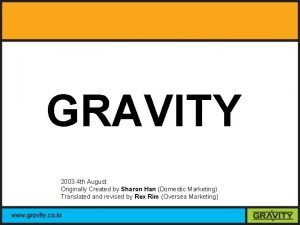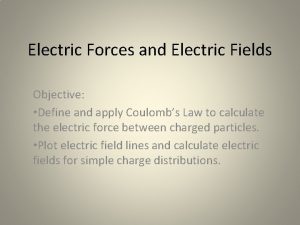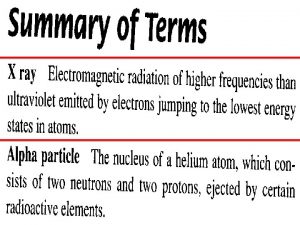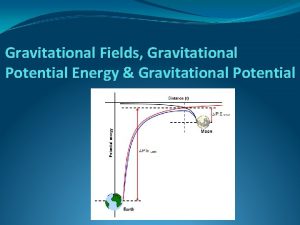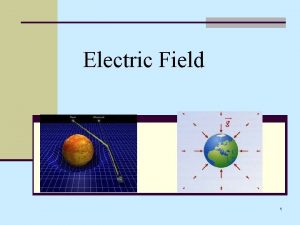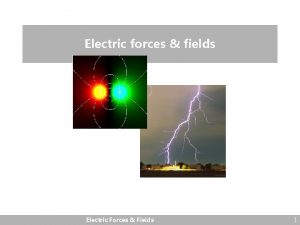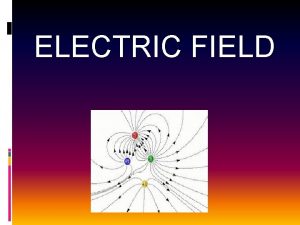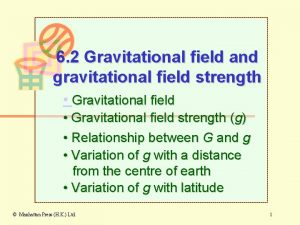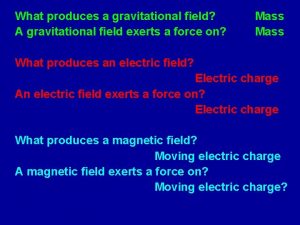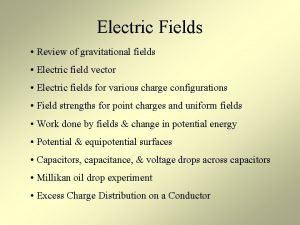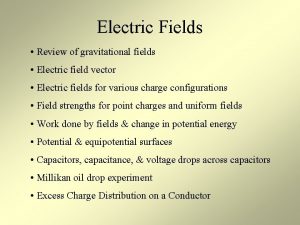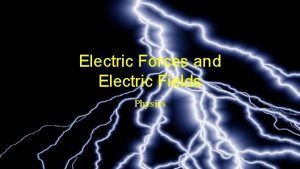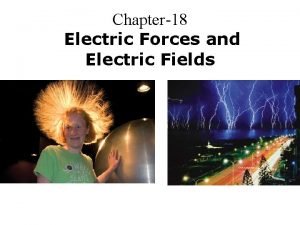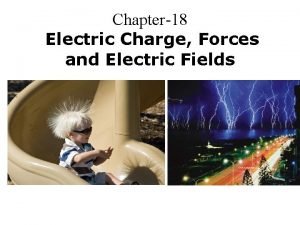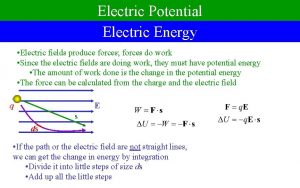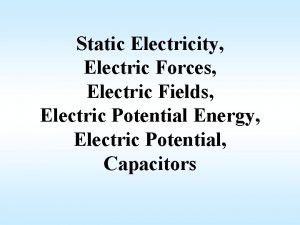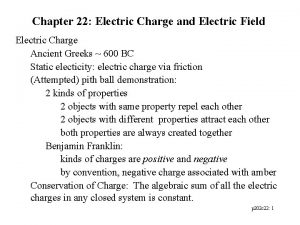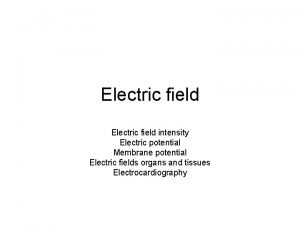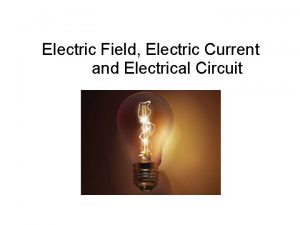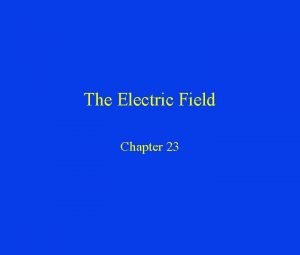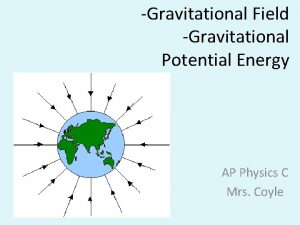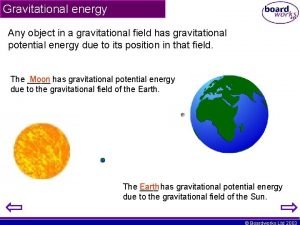Chapter 15 Field Forces The Electric Field Gravitational


























- Slides: 26

Chapter 15 Field Forces The Electric Field

• Gravitational force • Electromagnetic force • Strong nuclear force • Weak nuclear force

How different would life be if there were more ions around? We’re used to living in a world dominated by gravity. Let’s compare the force of gravity between two protons to the electrostatic force: Fg = G m p mp / r 2 Fe = k e e / r 2 *Note how similar these two look!


Let’s now take the ratio of the electrostatic force to the gravitational force: Fe k e 2 / r 2 = Fg G m p 2 / r 2 Note: this should be a unit-less quantity. Right? (9 X 109 N m 2/C 2)(1. 6 X 10 -19 C)2 = (6. 7 X 10 -11 N m 2/kg 2)(1. 67 X 10 -27 kg)2

Fe 2. 3 X 10 -28 C 2/ C 2 = Fg 1. 9 X 10 -64 kg 2/ kg 2 = 1. 2 X 1036 !!!!!! Good thing most objects are neutral, eh?

We said that like gravity, the electric force is a Field Force


The Earth has a gravitational field. We experience its effects on a daily basis. In fact, we describe it with the quantity g = 9. 81 m/s 2 Does the Earth’s gravity extend to the Moon’s surface?

But is that familiar expression for the Earth’s gravitational field still valid at the Moon’s surface?

That expression has been derived for conditions at the Earth’s surface. The more general expression for the Earth’s gravitational field is given by. . . The minus sign indicates that it is an attractive field that points toward the Earth’s center. . .

The familiar g is only one possible value of Ge. While G and me are constant, if we move away from the Earth (toward the moon, for example), the magnitude of Ge decreases like 1/r 2. Gravity is a field force -- that is, a force that acts at a distance without requiring physical contact.

Now that we have an expression for the gravitational field, we can determine the force on a given mass (like ourselves) from the expression: are you spending so much time on gravity? Didn’t we cover that last semester?

Everything we just did with gravity we can do with electricity, too! (and I think our intuition about gravity is better…)

An object with a charge (q) produces an electric field around it given by

So, when we bring a second charge (q) into the neighborhood of an existing charge, the second charge will feel a force due to the electric field of the first charge. That force is given by….

The superposition principle applies to the electric field, too! So…. The proof is rather straightforward…if you believe that the electrostatic force obeys the superposition principle. . .

Since we have a hard time visualizing a field, it is useful to develop the concept of field lines. Electric Field Lines indicate the direction and magnitude of the electric field at any point in space.

1) Begin on positive charges 2) End on negative charges 3) Point from positive to negative charge 4) Are most dense where the electric field is the strongest. 5) Are the least dense where the electric field is the weakest.

+ Field lines Far apart. - Field lines close together.

Looking at the electric field lines gives us a way to come to understand the 1/r 2 nature of the expression for electrostatic force… Let’s start in the 2 dimensional world first. . What is the density of lines passing through the blue circle? 8/2 prblue What about the green circle? 8/2 prgreen

So in flat-land, the density of lines goes down by 1/distance away from the convergence point of the lines. In the 3 -D world we live in, we replace the circles of flat-land with spheres. The density of lines passing through surrounding shells will decrease like 1/distance 2, since the surface area of a sphere is 4 pr 2

Points in the direction from 1 to 2! Example: q 1 r 1 q 2 r 2 q 3 y x q 1 = -1 m. C q 2 = -2 m. C q 3 = +1 m. C r 1 = 1 m r 2=2 m What is the Total Force on q 2? 1) Start by calculating the electric field of charge q 1 at the location of charge q 2. (i. e. , in the -x direction)

Points in the direction from 3 to 2! Example (con’t): q 1 r 1 q 2 r 2 q 3 y x q 1 = -1 m. C q 2 = -2 m. C q 3 = +1 m. C r 1 = 1 m r 2=2 m What is the Total Force on q 2? 2) Then examine the electric field of q 3 at q 2. (i. e. , in the -x direction)

Example (con’t): q 1 r 1 q 2 r 2 q 3 y x q 1 = -1 m. C q 2 = -2 m. C q 3 = +1 m. C r 1 = 1 m r 2=2 m What is the Total Force on q 2? 3) Next, use the superposition principle to carefully add together the results. (i. e. , the electric field at the location of q 2 points in the -x direction)

Example (con’t): q 1 r 1 q 2 r 2 q 3 y x q 1 = -1 m. C q 2 = -2 m. C q 3 = +1 m. C r 1 = 1 m r 2=2 m What is the Total Force on q 2? 4) Finally, multiply by q 2 to get the force. . . (i. e. , the electric force at the location of q 2 points in the +x direction)
 Chapter 21 electric charge and electric field
Chapter 21 electric charge and electric field Chapter 21 electric charge and electric field
Chapter 21 electric charge and electric field Coulombs constant units
Coulombs constant units Chapter 21 electric charge and electric field
Chapter 21 electric charge and electric field Electric charges and electric forces lesson outline
Electric charges and electric forces lesson outline Mention the expression
Mention the expression Potential due to a point charge
Potential due to a point charge Electric field lines
Electric field lines Electric potential from electric field
Electric potential from electric field Electric field and magnetic field difference
Electric field and magnetic field difference Distinguish between magnetic and nonmagnetic materials
Distinguish between magnetic and nonmagnetic materials Magnetic field
Magnetic field Chapter 16: electric forces and fields answers
Chapter 16: electric forces and fields answers Gravitational field ragnarok
Gravitational field ragnarok Gravitational field
Gravitational field Newton's law of gravitation
Newton's law of gravitation A suitable electric pump in an electric circuit is a
A suitable electric pump in an electric circuit is a Electric forces and fields concept review
Electric forces and fields concept review Define electric forces
Define electric forces Electric forces within an atomic nucleus tend to
Electric forces within an atomic nucleus tend to Parallel forces
Parallel forces The forces shown above are pushing/pulling forces
The forces shown above are pushing/pulling forces Intermolecular vs intramolecular forces
Intermolecular vs intramolecular forces Intermolecular forces ranked
Intermolecular forces ranked Intramolecular forces vs intermolecular forces
Intramolecular forces vs intermolecular forces What are some contact forces and some noncontact forces?
What are some contact forces and some noncontact forces? Unbalanced force
Unbalanced force













